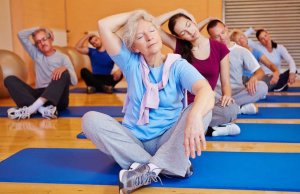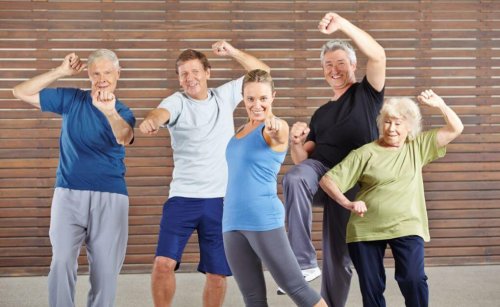Physical Exercise for Seniors

The idea of senior citizens sitting on a bench and watching life pass them by, is totally false. While rest is important, it should be combined with an active lifestyle. Physical exercise for seniors is the difference between a healthy life and an unhealthy one.
Who said that we should stop moving as we get older? On the contrary, physical activity becomes even more necessary after the age of 65. Many people retire at this age and stop being as active as they used to. Yet, this is exactly when your time and energy should go into doing an exercise that you enjoy.
Today, the possibilities are huge: you can start a new sport, use home exercise equipment, and/or visit places or join groups that offer exercise for seniors.
Benefits of physical exercise for seniors

As with all people, senior citizens benefit greatly from physical activity. Some of the positive results it produces are:
- Reduces the mortality rate of various illnesses, such as heart disease, hypertension, strokes, diabetes, colon and breast cancer, and depression.
- Significantly improves cardiorespiratory and muscular system performance.
- Strengthens muscles, creating better body mass and improving bone health.
- Enhances funtional health while reducing the risk of falling as well as moderate and severe functional limitations.
How much exercise should seniors do?
According to the World Health Organization, the ideal activities for seniors include:
- Recreational or leisure activities, such as low intensity games.
- Displacement exercise: short walks or bike rides.
- Occupational activities: those related to the workplace.
- Household chores: a practical way to stay active.
- Family sports or games: these, in addition to better overall health, have a clear and positive impact on emotional senses.
As for the duration of exercise, the same organization recommends spending 150 minutes each week. This is for moderate aerobic physical activities. However, if the activities are slightly more intense, the suggested time is 75 minutes, per week. It’s also okay to combine both, moderate and intense exercises, using the right timing.
The minimum amount of time per session should be 10 minutes. Additionally, for those that can handle longer moderate activity, a maximum of 300 minutes a week could enhance the benefits of physical exercise for seniors.
Finally, in regards to people with reduced mobility, it’s advisable to exercise at least three times a week. The goal is to improve balance and strengthen the main muscle groups.
What are the recommended activities?
We can separate physical exercise for seniors into four categories. The first includes aerobic or resistance workouts. These include: walking, jogging, swimming, dancing or cycling. All of these enhance both cardiac and respiratory systems.
Its effects can be seen in the boost of energy to perform daily tasks. They’re also very effective at preventing diseases related to aging.
Moreover, there are also strength-training exercises to consider. Working with elastic bands or weights helps to strengthen muscles. These workouts provide independence and help prevent diseases such as osteoporosis.
Balance exercises, the third group, contribute to preventing falls and improving posture. This includes various simple activities, that can even be considered as games.
Lastly, there are flexibility exercises, which are very important since they serve to stretch out muscles, prevent their atrophy, and relax the body. Both here and within the balance exercises, we can also include yoga and other similar disciplines.

Of course, everything that we have discussed is linked to each person’s physical capabilities. A medical consultation and a follow-up appointment is always recommended before starting exercise. This especially applies if you want to gradually increase the intensity of your workouts.
The idea of senior citizens sitting on a bench and watching life pass them by, is totally false. While rest is important, it should be combined with an active lifestyle. Physical exercise for seniors is the difference between a healthy life and an unhealthy one.
Who said that we should stop moving as we get older? On the contrary, physical activity becomes even more necessary after the age of 65. Many people retire at this age and stop being as active as they used to. Yet, this is exactly when your time and energy should go into doing an exercise that you enjoy.
Today, the possibilities are huge: you can start a new sport, use home exercise equipment, and/or visit places or join groups that offer exercise for seniors.
Benefits of physical exercise for seniors

As with all people, senior citizens benefit greatly from physical activity. Some of the positive results it produces are:
- Reduces the mortality rate of various illnesses, such as heart disease, hypertension, strokes, diabetes, colon and breast cancer, and depression.
- Significantly improves cardiorespiratory and muscular system performance.
- Strengthens muscles, creating better body mass and improving bone health.
- Enhances funtional health while reducing the risk of falling as well as moderate and severe functional limitations.
How much exercise should seniors do?
According to the World Health Organization, the ideal activities for seniors include:
- Recreational or leisure activities, such as low intensity games.
- Displacement exercise: short walks or bike rides.
- Occupational activities: those related to the workplace.
- Household chores: a practical way to stay active.
- Family sports or games: these, in addition to better overall health, have a clear and positive impact on emotional senses.
As for the duration of exercise, the same organization recommends spending 150 minutes each week. This is for moderate aerobic physical activities. However, if the activities are slightly more intense, the suggested time is 75 minutes, per week. It’s also okay to combine both, moderate and intense exercises, using the right timing.
The minimum amount of time per session should be 10 minutes. Additionally, for those that can handle longer moderate activity, a maximum of 300 minutes a week could enhance the benefits of physical exercise for seniors.
Finally, in regards to people with reduced mobility, it’s advisable to exercise at least three times a week. The goal is to improve balance and strengthen the main muscle groups.
What are the recommended activities?
We can separate physical exercise for seniors into four categories. The first includes aerobic or resistance workouts. These include: walking, jogging, swimming, dancing or cycling. All of these enhance both cardiac and respiratory systems.
Its effects can be seen in the boost of energy to perform daily tasks. They’re also very effective at preventing diseases related to aging.
Moreover, there are also strength-training exercises to consider. Working with elastic bands or weights helps to strengthen muscles. These workouts provide independence and help prevent diseases such as osteoporosis.
Balance exercises, the third group, contribute to preventing falls and improving posture. This includes various simple activities, that can even be considered as games.
Lastly, there are flexibility exercises, which are very important since they serve to stretch out muscles, prevent their atrophy, and relax the body. Both here and within the balance exercises, we can also include yoga and other similar disciplines.

Of course, everything that we have discussed is linked to each person’s physical capabilities. A medical consultation and a follow-up appointment is always recommended before starting exercise. This especially applies if you want to gradually increase the intensity of your workouts.
This text is provided for informational purposes only and does not replace consultation with a professional. If in doubt, consult your specialist.








